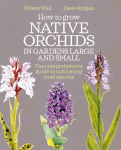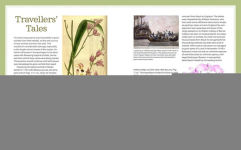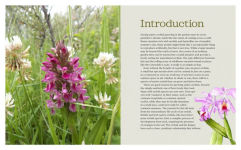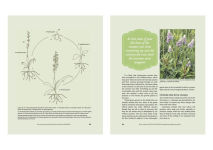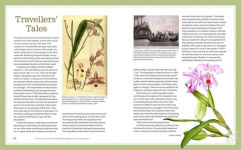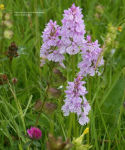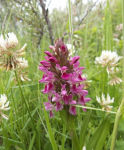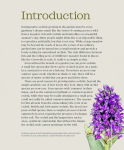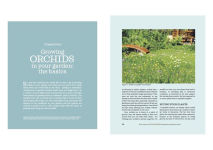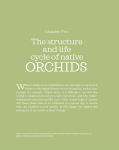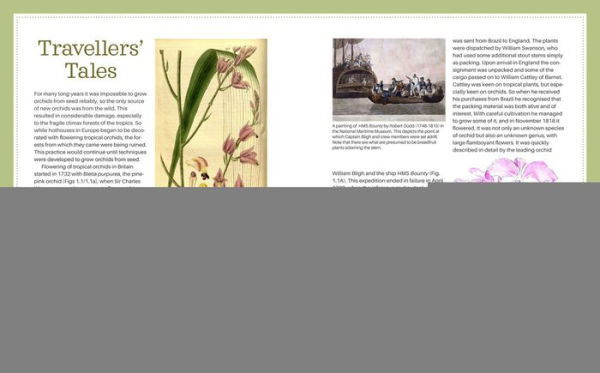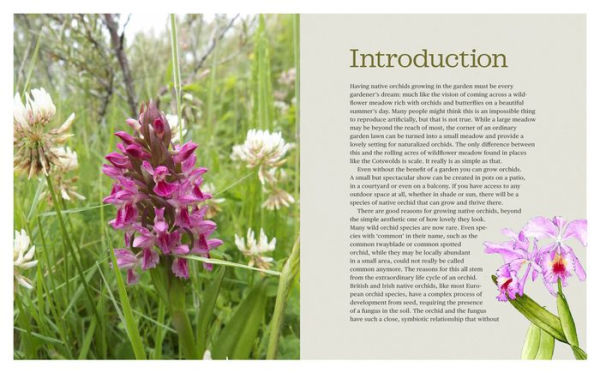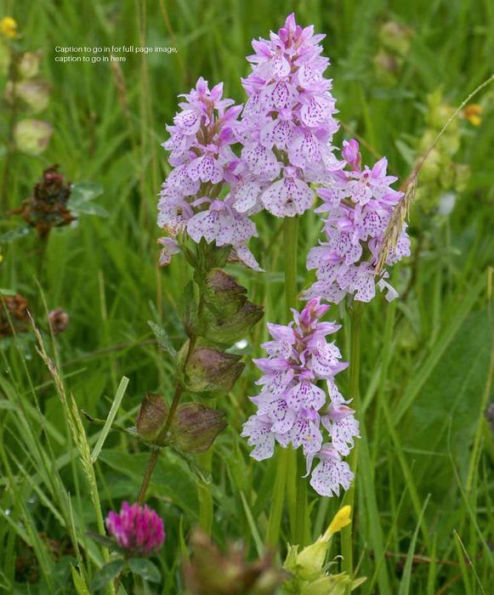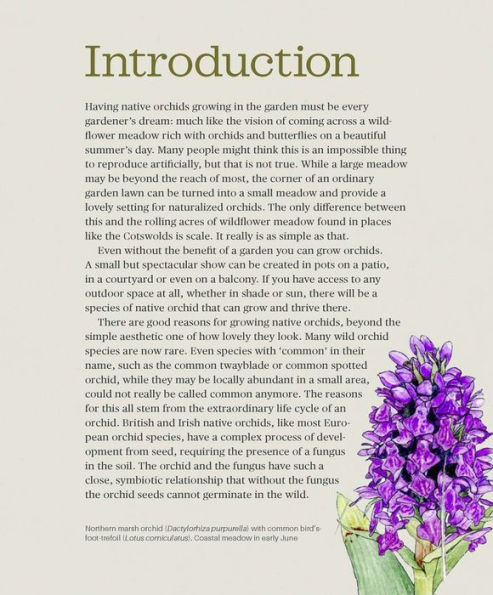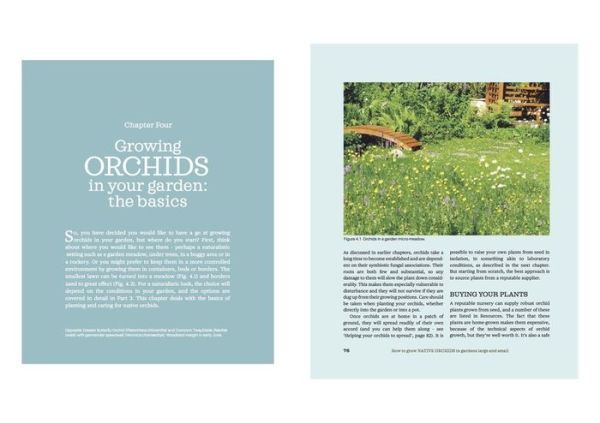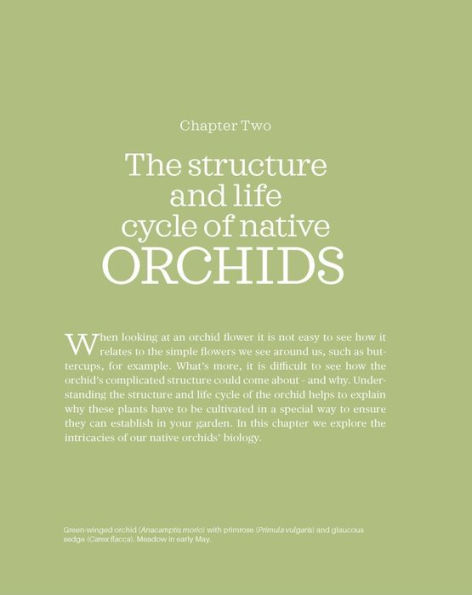
How to Grow Native Orchids in Gardens Large and Small: the comprehensive guide to cultivating local species
176
How to Grow Native Orchids in Gardens Large and Small: the comprehensive guide to cultivating local species
176Hardcover(First Edition)
-
SHIP THIS ITEMTemporarily Out of Stock Online
-
PICK UP IN STORE
Your local store may have stock of this item.
Available within 2 business hours
Related collections and offers
Overview

Product Details
| ISBN-13: | 9780857844606 |
|---|---|
| Publisher: | Bloomsbury USA |
| Publication date: | 09/05/2019 |
| Edition description: | First Edition |
| Pages: | 176 |
| Product dimensions: | 8.30(w) x 10.30(h) x 0.70(d) |
About the Author
Dave is an active member of the Botanical Society of Britain and Ireland (BSBI). With a PhD in plant physiology, his previous articles are on his research in plant physiology and for the Orchid Review and The Clematis. His paintings are regularly exhibited.
Read an Excerpt
CHAPTER 1
A love
affair with
ORCHIDS
Whether it is the shape of the flower, the colours or the rarity, orchids hold a fascination for us all. In Northern Europe these special plants are indicators of a healthy meadow, the flower standing proud in a splash of colour shouting "Look at me – I am an orchid!" We became enchanted by orchids, first by impressive tropical blooms and then by more subtle native flowers, once growers realised they were the same plant and that these apparently different flowers have a common shape, consistent across all orchid species, regardless of size or where they come from.
A BRIEF HISTORY OF ORCHID DISCOVERY
Although this book is about cultivation of native orchids in the garden, the broader history of these plants is fascinating and worth a short digression. It has involved explorers, fortunes, skullduggery, maps written in code and amazing stories of chance.
Orchid-growing in Britain started with the collection of the large and blowsy tropical types, which were brought back as botanical samples. Native orchids were regarded as common wild flowers and few people realized that they were botanically identical to the exotic orchids, only smaller.
Trade in tropical orchids started in the seventeenth century, when these beautiful flowers captured the imagination of the public. Great efforts were made to transport live plants, with limited success, and it was a long time before any serious attempt at growing them from seed was made.
By the nineteenth century, demand for imported orchids was immense, and attention turned to cultivation from seed. An entire capsule of thousands of seeds might produce only a single delicate seedling and as the seedlings suffered such high mortality (for reasons then unknown), it was impossible to grow orchids from seed reliably. The only source of new orchids was from the wild, and collecting for this lucrative market was big business, leading to problems of over-collecting. In A History of Gardening in England (1895), Alicia Amherst wrote that orchids were packed off in their thousands, leaving their native habitats bare. Collectors of Miltonia vexillaria in Brazil pillaged the area that they were searching so it had "become pretty well cleared". In Travels and Adventures of an Orchid Hunter (1891), Albert Millican wrote that ten thousand Curled Odontoglossums were collected by cutting down four thousand trees, the camps being moved on week by week as all the plants were taken from each area.
While hothouses in Europe began to be decorated with flowering tropical orchids, the forests from which they came were being ruined. This would continue until botanists learned how to grow orchids from seed.
IN SUMMARY
Growing orchids has been a passion of gardeners for a very long time. Originally the focus was on tropical species, but attention has now turned to our exquisite native species. The experience of seeing these lovely flowers in the countryside always lifts the spirits, but they have suffered significant depletion as a result of habitat loss, so by growing them in the garden you are making an important contribution to their conservation.
CHAPTER 2HARDY ORCHIDS:
conservation, habitat and growing conditions
The native orchids of the British Isles are more modest-looking and compact than the exotic-looking tropical type sold in florists' shops and garden centres. They are not only superficially different in appearance, but require different habitats and growing conditions.
In the next chapter we will look at the life cycle of the native orchids of the British Isles. But for now we turn our attention to their natural habitats, to discover the growing conditions needed for successful cultivation. Once you know the requirements of individual species, which we discuss in detail in Chapter 3, you will be able to select the plants that are most likely to prosper in your soil; alternatively, with careful manipulation of the compost in containers, you will be able to grow the whole range of native orchids. The usual manuring, mulching, and so on, are not necessary: as long as our orchids have their preferred soil type and levels of sun or shade, they are not very fussy!
CONSERVATION
Orchids were once much more widespread across the whole of the British Isles than now. Some were so common that they were used to produce drinks – saloup, for example, a decoction of Early Purple Orchid root that was taken on board Captain Cook's Endeavour as a means of preventing scurvy.
Before modern agricultural techniques became prevalent, plants such as the Green-winged Orchid thrived. VS Summerhayes, in Wild Orchids of Britain (1951), says of this species: "(It) is one of the commonest of British orchids ... not only is the species widespread, but also it sometimes occurs in immense numbers – literally in thousands or tens of thousands – so that the ground is made purple by the innumerable flower-spikes." To read Summerhayes is to rue the loss of the unimproved flower meadow: these days it is very unusual indeed to see enough orchid flowers to colour a meadow. The Green-winged Orchid was once plentiful in Derbyshire, for example, but its last site was ploughed in 1975 and there are only two records of this species in the wild since 2000.
However, despite the loss of orchid habitat in many areas, there are encouraging reports of orchids appearing in places that have been left undisturbed. Richard Mabey's Flora Britannica (1996) records that "Green-winged orchids made an unexpected (and unprecedented) appearance at short mid-wicket on the cricket ground at Stansted Park in West Sussex in May 1992." In Staffordshire, the creation of an artificial wild-flower meadow led to Green-winged Orchids first reappearing in 1999, with many dozens flowering in 2004. A 2016 British Wildlife report on the fields of County Mayo, which are used for grazing and still unimproved, comments that "lesser butterfly orchids still turn many pastures white in June" and "marsh orchids colour road verges, pastures and shores of loughs red". These plants – past and present – were not tended or cosseted in any way; they appeared of their own accord and survived the agricultural practices of the land where they grew.
These days it is hard for farmers to manage land economically and in a way that suits orchids and other wild flowers, though this is not a new problem. In The Life of the Fields (1884), Richard Jefferies describes how, with the coming of the railways in the late nineteenth century, there was a renaissance in dairy farming because milk could now be delivered to the big cities from deep in the countryside. Agricultural improvements were made that damaged the wild habitat – including re-sowing meadows and the careful eradication of "rattles and similar plants destructive to the hay crop".
Managing land to suit orchids is not always easy for conservation bodies either, because it requires effort and expense. A few years ago we visited a nature reserve in Somerset where the Green-winged Orchids were few and far between, as the grasses hadn't been kept down by grazing or cutting – yet there were large numbers of them just over the hedge on farmed meadowland.
FAVOURED HABITAT AND GROWING CONDITIONS
The orchids of Britain and Ireland favour certain habitats:
• meadows on neutral soils (Fig. 1.1)
• grassland on limestone or chalk (Fig. 1.2)
• woodland rides on moist soils and sand dunes (Fig. 1.3) (unsuitable for the garden, but we mention them only for completeness)
An orchid's preference for its habitat is determined by three key factors:
• soil conditions
• competition for light
• temperature
These factors interact, and it is the balance that determines which species will grow in a particular place.
Soil conditions
Soil conditions have the most important influence on orchid growth, with pH and levels of water and nutrients being key factors. Table 3.3 in Chapter 3 outlines the preferred conditions for the native species we recommend for cultivation.
Many of our native orchids are found growing in the more alkaline soils that overlie chalk or limestone. Such soils have low fertility because of the way that the soil chemistry works: although the mineral content of the water running through it is high, nutrients like iron, manganese and phosphorus are not readily available to plants. Orchids that prefer alkaline conditions also grow where minerals are washed out of the soil or in acid soil, where the groundwater that runs through the soil flows from limestone. So subterranean alkaline flushes of water on mountainsides that are otherwise acid heath or bog can provide a home for lime-loving orchid species.
Orchids tend to be found on the thinner soils of hill slopes, rather than the deeper soils of valley bottoms, because:
• the soil on the slopes is thinner and poorer, with a higher pH (lime content), which orchids love, compared with the richer, deeper soils in the valley;
• the lime has been washed out or diluted by the higher organic content of the valley-bottom soils;
• the slopes are at the limit of the orchid's geographical distribution and such thin soils hold less water and warm up more quickly in the spring;
• orchids do not need to compete with the more vigorous plants growing in the richer soils of the valley bottoms.
Not all of our native orchids are lime-loving. The Heath Spotted Orchid and Common Spotted Orchid are the most acid-tolerant of the native orchids and excellent candidates for growing in gardens.
Competition for light Most of our native orchids prefer sunny conditions, though those that grow in woodland have adapted to cope with shade. Consequently, our woodland orchids can be split into two groups: shade avoiders and shade tolerators.
The Early Purple Orchid and Greater Butterfly Orchid are shade avoiders. They flower early in the year before the tree canopy is fully formed, or grow at the edges of woods and in clearings, where there is more light. Shade tolerators grow in deeper shade and tend to flower later, when the tree canopy is fully expanded. Some native orchids that grow in the deepest shade have lost all of their chlorophyll (the green pigment of plants that captures the energy of sunlight). They live entirely off their fungal associate, but are unsuitable for growing in the garden. Chapter 8 gives more detail on species suitable for shady areas.
Outside woodland, native orchids will grow where there is reduced competition with more vigorous species for both light and nutrients. For example, growing on thin soils, where grazing is minimized; in meadows full of plants such as yellow rattle, which help stunt grasses; or on wet land where the lusher plants grow later in the year.
For the gardener, it's important to ensure that your orchids receive enough light to enable them both to flower and to produce sufficient food for the next season. If most of your garden is too shady and acid for your choice of orchid, grow them in containers (which we cover in Chapter 4). If you like to grow spring- or earlysummer-flowering orchids, extend the flowering display by mixed plantings with later-flowering plants, but don't let them overtop or crowd out the orchids until these have flowered and begun to wither. Chapters 4, 7, 8 and 9 include ideas for suitable plants to combine with orchids in your garden.
Temperature
The temperature range for orchids is quite large. Higher temperatures are tolerated, as long as adequate water is available. If there is a drought, though, a high temperature will severely harm the plant as water loss increases. On the other hand, when the orchids are dormant in winter, less water is better as this reduces the problems of root rot that can occur at low temperatures. As most of our native orchids are winter dormant, we will return to the distinction between them and winter-green species in Chapter 2.
IN SUMMARY
Once established, our native orchids are robust plants and a delight to grow. While getting them started can be a challenge, it is well worth it for the sheer joy of success. The trick is to get them established so that they can thrive and become a special part of your garden flora.
If you reproduce the agricultural practices of yesteryear on a small scale in your garden, and select the right orchids, you will be recreating a slice of the once-magnificent 'natural' gardens our grandparents would have known.
CHAPTER 3The structure and life cycle of native ORCHIDS
When looking at an orchid flower, it's difficult to see how its seemingly complex structure could come about – and why. Understanding this structure and the life cycle of the plant helps explain why orchids have to be cultivated in a special way to ensure they can establish in your garden. In this chapter we explore the intricacies of our native orchids' biology.
THE STRUCTURE OF AN ORCHID FLOWER
Orchids are monocotyledons or monocots: flowering plants that germinate with a single seed leaf (cotyledon). They are perennials that grow from a fleshy root or tuber, and their flowers have a distinguishable shape that is consistent among all orchid species. (Monocots are the smaller group of the two categories of flowering plants, dicotyledons and monocotyledons. They typically have long, stalkless leaves, e.g. grasses, lilies, palms and orchids have their own family, Orchidaceae, within this group.)
Although the native orchids of the British Isles have flower spikes made up of small flowers, the individual flowers are essentially the same as those of the large single flowers of tropical species. Take a close look at a flower on a wild orchid to see how they really are no different, biologically, from the blowsy tropical versions. They are just smaller.
The prominent parts of the orchid flower are the three petals and the three sepals, which start life as covers for the flower bud. Each set of three is placed roughly equidistantly in a whorl, and the two whorls are offset by about 60 degrees. If the petals and sepals were all the same shape, the flower would look like a six-pointed star. In most orchids, when the flower opens, the top point of the star is a sepal (the upper sepal) and the bottom point of the star is a petal (the lip). The other sepals and petals are the points at the two sides of the star, one of each on each side (the lateral sepals and lateral petals). This structure is illustrated in Figures 2.1 and 2.2.
Sun Orchids, from the southern hemisphere, have such starshaped flowers, but most orchids, including our native species, have modified sepals or petals or both, so the flowers are bilaterally symmetrical and the star-shaped structure is not always obvious.
In the tropical Slipper Orchids (Fig. 2.1), the lateral sepals are reduced and fused into one structure, the upper sepal is hugely expanded and embellished, and the lip is curled upwards to form a large pitcher.
Figure 2.2 shows three examples of British and Irish native orchid flowers. In the Common Spotted Orchid, the upper sepal and lateral petals are formed into a hood; the Bee Orchid has a large balloon-shaped lip, and the lateral petals are reduced to short tubular structures; the lip of the Marsh Helleborine is divided into two parts – a 'landing stage' at the front (the epichile) and a cup for nectar at the back (the hypochile).
Unique to orchids is the column, which is a fusion of the structures that carry the pollen-producing cells and the pollen-receiving cells. After pollination, the seeds are produced in the ovary, situated at the back of the flower, where there is sometimes a spur – a hollow organ with nectar at the very bottom to entice long-tongued pollinators.
All orchid flowers – whether on a single stem in a tropical rainforest or on a flower spike in a British meadow – rotate on their flower stalks before opening; in most cases through 180 degrees. This brings the flower the right way up for the function it is to serve, placing the lip at the bottom as a 'landing stage' for pollinators, with the column above. If you look at the flower stalk of an orchid, you should be able to see the twist. This is clearly shown in the loose flower spike of the Greater Butterfly Orchid (Fig. 2.3). The Bog Orchid has a stalk rotation of a full 360 degrees, bringing the flower back to its original orientation, but the advantage of this curious flower rotation remains unknown.
All these features of the orchid flower are associated with attracting pollinating insects, and often it is a unique association – one orchid species with one insect – that has resulted in the vast range of orchid flower shapes. They are designed so that the insect can only approach from one direction. At the same time the 'face' of the orchid is often so developed that it looks like a specific insect, usually a bee or wasp species, so that it attracts males into thinking it is a female mate. This effect is sometimes compounded by the orchid producing a scent that is a very close analogue of the attraction pheromone for that specific insect.
THE IDIOSYNCRASIES OF ORCHID SEED
Unlike the seeds of tropical orchids, which germinate in light, seeds of orchids native to Northern Europe will only germinate in darkness. All orchid seeds are very small – the smallest seeds in the world. Quite how minute they are can be seen in Figures 2.4 to 2.6. The seed is like dust – and, like dust, it is easily blown in the wind. To achieve this small size, the endosperm – the food-containing tissue within a seed, normally full of starch – is absent; and the embryo is tiny – only a small ball of cells, accompanied by some oil droplets and starch grains. If you break open a ripe orchid seed capsule on a still day, the seeds fall out looking like a wisp of smoke, but they fall to earth within a few feet. On a windy day they disappear into the distance, to settle when the wind drops or the rain washes them out of the air.
Orchid seeds also all exhibit a very specific pattern of construction, visible in Figures 2.4 and 2.5. Only the practised eye can separate orchid seeds into different groups and identify an orchid with any confidence from its seed alone.
Although seed production is enormous, the tiny seeds have no energy reserves on which to call. In this they differ from the seed of virtually every other plant, which can rely on their food reserves until they produce leaves and start to photosynthesize. As we saw in Chapter 1, what orchids need in nature is a symbiotic fungus to provide them with essential nutrients while they get started. Many plants have symbiotic fungal associations, helping with the uptake of phosphates and nitrogen, but these fungal associates are more fundamental for orchids. They provide the energy the plant needs in the form of sugars, which are essential for growth in the first stages of the plant's life, and it can take years before an orchid produces its first leaf and starts to actively photosynthesize. When orchids are germinated in artificial conditions, however, a special growth medium can take the place of this symbiotic fungus and provide all the necessary nutrients.
With this slow rate of growth and the threats that a plant must survive before it gets to flowering size, it is no wonder that even common orchid species are not common except in local colonies – and that they cope with the challenges of germination by producing huge amounts of seed. For example, a well-grown Common Spotted Orchid produces half a million seeds every year, so that a handful will find the right conditions to grow.
What this means for the gardener
Our native orchids have a long life. In perfect conditions, some species take only a month to germinate, while others will take six months to a year before they start to produce a shoot or root, before spending one or two years underground.
(Continues…)
Excerpted from "How to Grow Native Orchids: In Gardens Large and Small"
by .
Copyright © 2019 UIT Cambridge Ltd..
Excerpted by permission of UIT Cambridge Ltd.
All rights reserved. No part of this excerpt may be reproduced or reprinted without permission in writing from the publisher.
Excerpts are provided by Dial-A-Book Inc. solely for the personal use of visitors to this web site.
Table of Contents
Introduction
Part 1: Understanding orchids
A love affair with orchids
The structure and life cycle of native orchids
Native orchids suitable for cultivation
Part 2: Cultivation
Growing orchids in your garden: the basics
Raising plants from seed
Pests and diseases
Part 3: Orchid communities
Creating a garden meadow
An orchid orchard or garden glade
Orchids in rockeries or damp ground
Repopulating wild areas
Resources
